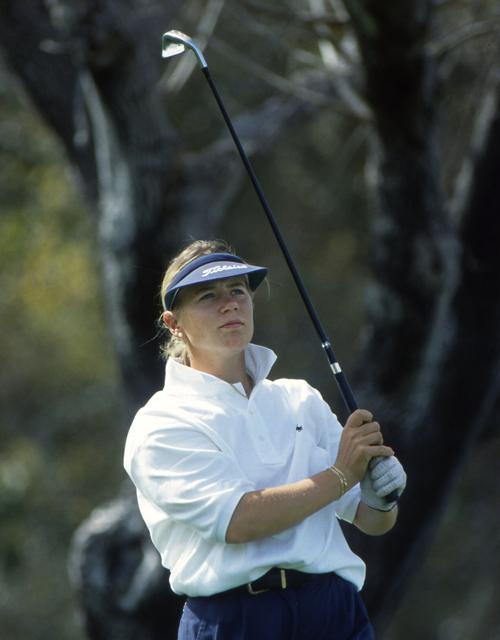As much or more than any of Arizona’s many All-American golfers, Annika Sorenstam became familiar with Tucson’s mid-winter “frost delays,” which often push the day’s tee times from 7 a.m. to 9 a.m. or a bit later.
Sorenstam was an early riser, regularly driving from her apartment near the Tucson Racquet Club to the Randolph Golf Complex before her morning classes. If she was delayed an hour or two, her daily routine of getting to the practice area adjacent to Randolph North’s No. 18 was unhappily scuttled.
She was often the first to arrive at the practice complex, whether it be 38 degrees or 68 degrees.
“I wish there were 48 hours in a day,” Sorenstam said in 1992. “I want to spend more time studying and more time practicing golf. I love to be on the range by myself.”
At the time of her final appearance in an Arizona uniform — at the 1992 NCAA championships — Sorenstam was the top-ranked women’s college golfer in America. The Wildcats were similarly ranked No. 1. The quiet, almost shy young golfer from Stockholm, Sweden, was no longer a secret.
She had won the 1991 NCAA championship, the most promising young female golfer to come along since Nancy Lopez a generation earlier.
“Annika’s about as perfect as they come,” said UA coach Kim Haddow. “She’s got a passion for the game that the top athletes have.”

Entering the ’92 national finals at ASU’s Karsten Golf Course, Arizona had won seven of its eight previous tournaments, a modern NCAA record. Fellow sophomore Leta Lindley was ranked No. 3 nationally. Junior Debbie Parks was ranked No. 7.
Haddow’s ’92 women’s golf team was considered more every bit as formidable as Arizona’s 1992 men’s golf team, which would win the NCAA title a week later.
The union of Haddow and Sorenstam, forming the nation’s No. 1 women’s golf team in both 1991 and 1992, was about as unlikely as any in UA sports history.
Nine years earlier, Haddow, an SMU grad, had been a physics teacher at Sahuarita High School, keeping her hand in the game she grew up playing, getting part-time work as an assistant pro/instructor at Tucson Country Club.
Sorenstam, who began playing golf seriously at 13, had emerged as Sweden’s top teenage golfer, being coached and mentored at Stockholm’s Gymasiet High School by Pia Niellsen, a former ASU golf standout who had played five seasons on the LPGA Tour.
In the summer of 1989, Sorenstam played for Sweden in the annual Shiseido Open in Japan, which attracted college golf coaches from America. Haddow had never heard of Sorenstam. But by the luck of the draw, Sorenstam was paired with the UA’s top golfer, Martina Koch.
After two rounds, Koch told Haddow “let’s get her.”
It’s not like recruiting Sorenstam was a long shot. Arizona had finished No. 4 in the NCAA two years earlier and Haddow had built a national power; UA sophomore Susan Slaughter won the individual 1989 national championship.
But what baffled Haddow was that ASU had not recruited Sorenstam. Nobody had.
“No other college ever contacted me,” Sorenstam told me in 1992. “I didn’t even visit Tucson. Before I left home, I told my parents ‘see you in nine months.’ If i don’t like it, I could always come back.”
Sorenstam loved the year-round practice facilities and improved her game so much via those early morning workouts that in her final season at Arizona, 1992, she averaged 72.3 strokes per round, a Pac-10 record. She won four tournaments, a school record.
With Lindley, Parks and the nation’s No. 17 golfer, Ulrika Johansson in the lineup, Arizona was heavily favored at the 1992 NCAA finals. The Wildcats had won seven of their last eight events by such margins as 43, 33, 30 and 24 strokes.
But over those four days in Tempe, Arizona finished No. 2, behind then-national power San Jose State. Sorenstam’s quest to become the first women’s golfer in NCAA history to win back-to-back championships ended when Georgia’s Vicki Goetz shattered the tournament record, shooting 7-under 65 on the final day.
Both Sorenstam and the Wildcats finished No. 2 overall.
Having attracted so much attention in the golf community, Haddow was soon hired to be the head coach at Florida. Sorenstam jumped to the LGPA Tour, where she won 72 events and 10 majors, records that stand today. Lindley also became a successful LPGA player, winning the 2008 Corning Classic and finishing in the top 10 in 33 events.
The ’92 Arizona golf women’s team might be the best team, any sport, in school history not to win the national championship. Four years later the Wildcats would break through and win the first of three NCAA titles.
By then Sorenstam had won the women’s U.S. Open twice. Ultimately, it all worked out for the team of 1992.






